This article has been reviewed according to Science X's editorial process and policies. Editors have highlighted the following attributes while ensuring the content's credibility:
fact-checked
peer-reviewed publication
trusted source
proofread
Contours that kill: Geometry influences prey capture in carnivorous pitcher plants
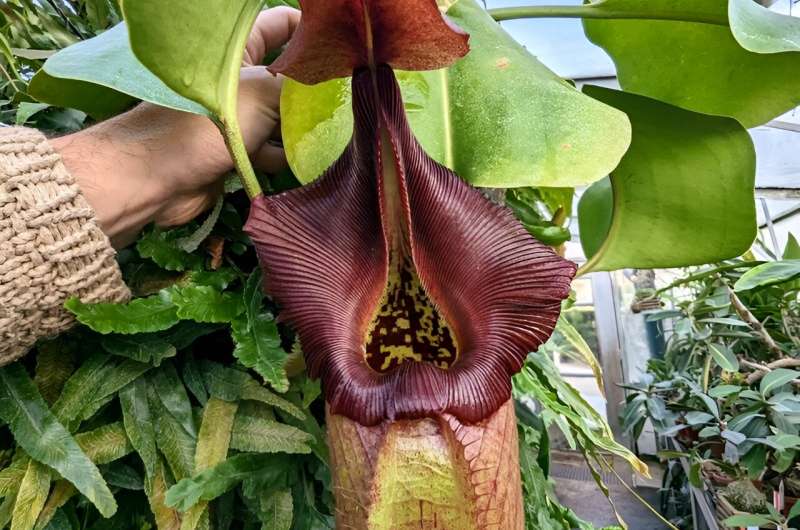
Researchers at the University of Oxford's Botanic Garden and the Mathematical Institute have shown that the shape, size, and geometry of carnivorous pitcher plants determines the type of prey they trap. The results have been published today in the Proceedings of the National Academy of Sciences (PNAS).
Pitcher plants (genus Nepenthes) are a type of carnivorous plant found in the tropics, especially in Southeast Asia. Their name refers to the hollow, cup-like structures they produce to capture animal prey (typically insects). Pitcher plants come in an enormous variety of shapes and sizes from tubes to goblets, some even with spine-like "teeth"—but why they differ so markedly is a mystery.
"I first encountered these extraordinary plants in the wild in Southeast Asia nearly twenty years ago," recalls Dr. Chris Thorogood, botanist and Deputy Director of Oxford Botanic Garden. "I remember wondering: how and why do they vary so much? To have helped solve this mystery is truly exciting."
The mechanism by which pitcher plants capture prey is well known: each pitcher has a slippery rim at the top, called a peristome, covered in ridges that collect a film of water. This causes the prey to skid and fall into a pool of digestive juices at the bottom of the pitcher, similar to a car aquaplaning on water.
But although this process is common to all pitcher plants, the shape of the rim ranges from simple cylinders, to highly ornate, fluted, or toothed structures. The more lavish the rim, the greater the cost to produce it: so why don't all pitcher plants just produce a simple structure?
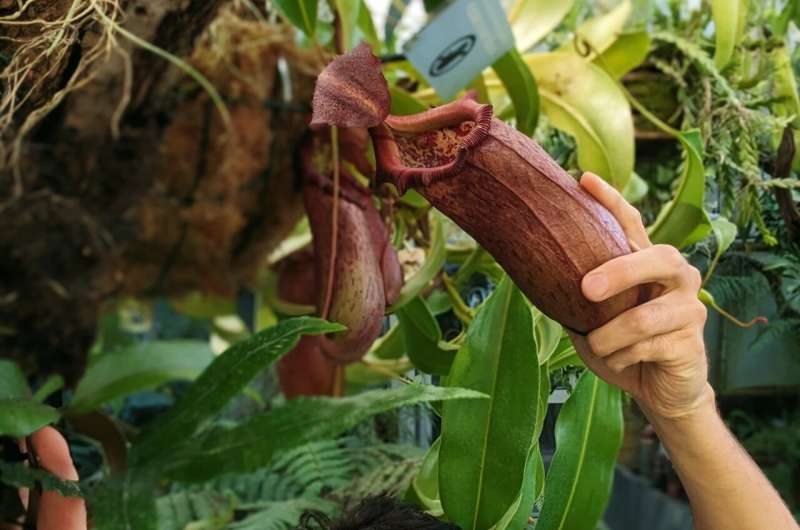
To address this question, the team applied mathematical models to pitcher plants grown at the Botanic Garden, to see what effect the rim's shape has on prey capture. Shapes were classified into four groups that exist in nature and could be easily compared using mathematical reconstructions. Hypothetical capture efficiencies were measured for each shape using a "point mass"—the equivalent of an insect sliding into the trap. The energetic cost of producing the rim was then calculated by examining the relative area and steepness of the different structures.
Derek Moulton, Professor of Applied Mathematics at the University of Oxford's Mathematical Institute, explained: "Mathematical reconstructions enable us to explore the trade-offs that exist in these plants in nature. Large, flared rims are costly for a plant to produce. By simulating both realistic peristomes and extreme versions—geometries that don't exist in nature—we were able to show that in an optimal structure, the cost of production might be offset by the extra prey that can be caught."
"A similar situation exists regarding trap size," added Dr. Hadrien Oliveri, Postdoctoral Researcher at the University of Oxford's Mathematical Institute. "We might expect the size of the rim to correlate with the prey most commonly available in a given habitat—be that ants or beetles, for example."
To investigate the impact of the trap size, the team developed a mathematical model to link the 3D geometries of pitcher plant rims with the physical mechanics of prey capture. The model incorporated geometrical features of the rims—including width, degree of flaring, and orientation—and the stability and sliding direction of prey placed at various points.
The results suggested that variations in peristome geometries had a profound effect on what the plant could catch. For example, the geometry of highly flared peristomes appeared to be particularly suited to capturing walking insects such as ants.
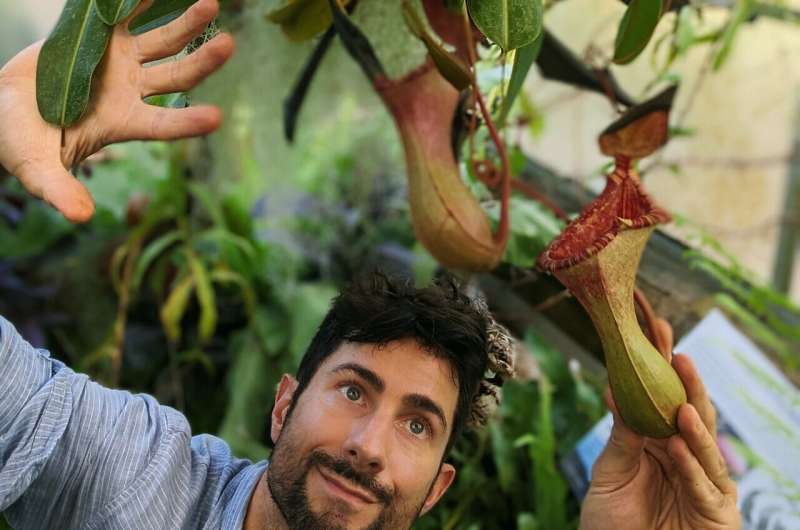
Pitcher plants in nature are found in nitrogen-poor environments—such as mountain slopes, swamps and tropical forests. This means their ability to capture nitrogen from trapped insects gives them an advantage over non-carnivorous plants. Each of these habitats has a unique combination of potential prey, raising the possibility that pitcher plants evolved a variety of traps to tap into the various types of available insects in a given place.
"Just as birds' beaks are shaped differently to feed on nuts, seeds, or insects and so on," explained Dr. Thorogood, "these pitcher plants are well-adapted to the different forms of prey that exist in their environments."
But despite the popular appeal of these 'green predators," studying them in the wild can be difficult. Consequently, mathematical approaches can be a powerful way to shed light on these botanical curiosities.
"Observing these plants in their natural environments is of course the best way to understand them. But many of these plants grow in remote, inhospitable places, so studying them in nature can be challenging," said Dr. Thorogood.
-
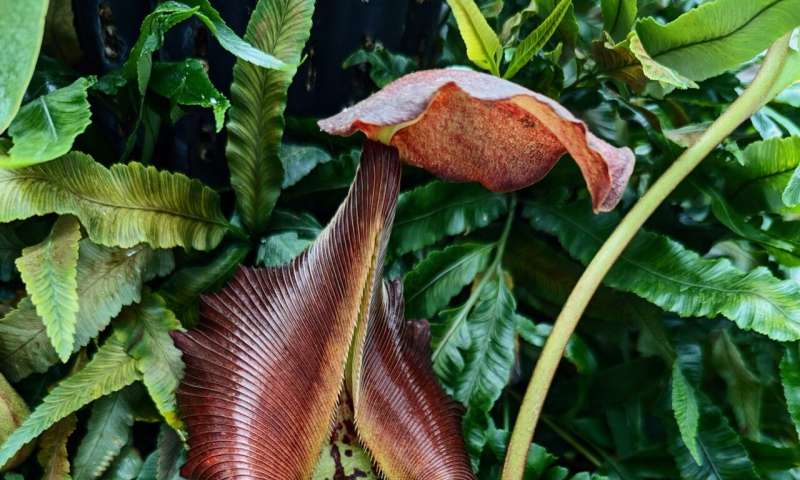
Nepenthes pitcher plants. Credit: Chris Thorogood. -
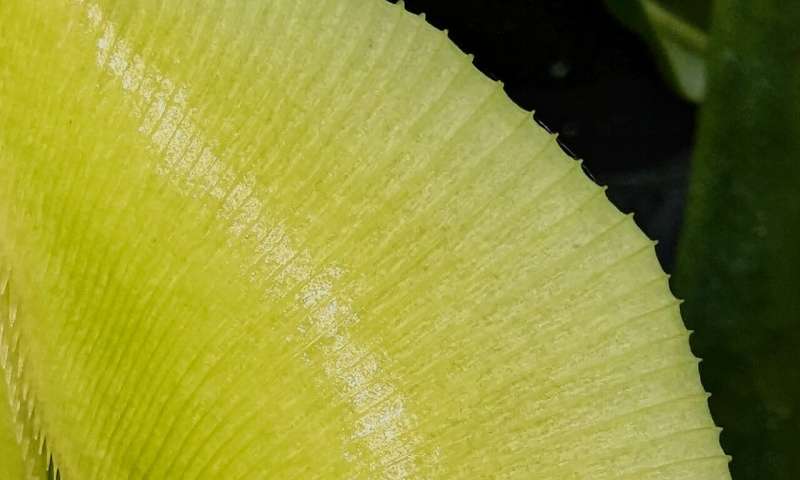
The deadly rim of the pitcher plant's trap. Credit: Chris Thorogood.
"Working together is a powerful way for mathematicians and biologists to understand how and why such extraordinary organisms evolved, and to come up with new hypotheses," said Alain Goriely, Professor of Mathematical Modeling at the Mathematical Institute. "Mathematical modeling enables us to test them."
The team plans to continue their work on pitcher plants, and other plants grown at the Botanic Garden—a living library for scientists to explore.
More information: Derek E. Moulton et al, Mechanics reveals the role of peristome geometry in prey capture in carnivorous pitcher plants ( Nepenthes ), Proceedings of the National Academy of Sciences (2023). DOI: 10.1073/pnas.2306268120
Journal information: Proceedings of the National Academy of Sciences
Provided by University of Oxford





















